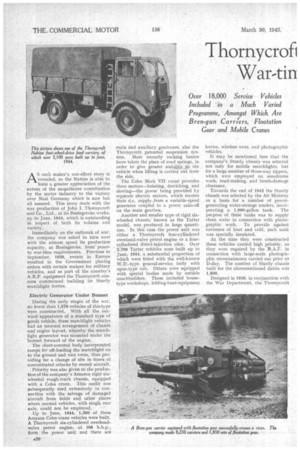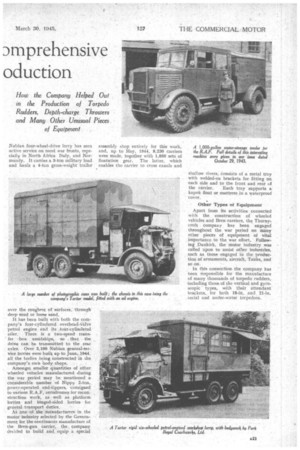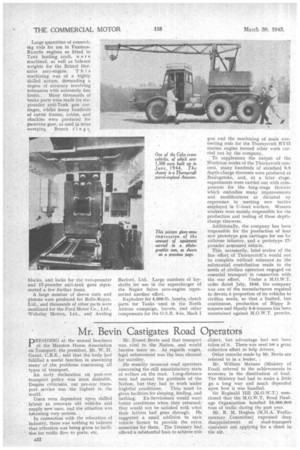Thornycrofi War-tin
Page 22

Page 23

Page 24

If you've noticed an error in this article please click here to report it so we can fix it.
Dmprehensive oduction
Over 18,000 Service Vehicles Included in a Much Varied Programme, Amongst Which Are Bren-gun Carriers, Floatation
Gear and Mobile Cranes How the Company Helped Out in the Production a] Torpedo Rudders, Depth-charge Throwers and Many Other Unusual Pieces ol Equipment
AS each maker's war-effort story is revealed, so the Nation is able to form a greater appreciation of the extent of the magnificent contribution by the motor industry to the victory over Nazi Germany which is now but all -assured. This story deals with the war production of John I. Thornycroft and Co., Ltd., at its Basingstoke works, up to June, 1944, which is outstanding in respect of both its volume and variety, Immediately on the outbreak of war, the company was asked to turn over with the utmost speed its production capacity, at Basingstoke, from–peaceto war-time requirements. Previous to September, 1939, events in Europe resulted in the Government placing orders with certain makers for military vehicles, and as part of the country's A.R.P. equipment the Thornycroft concern commenced building its Sturdy searchlight lorries.
Electric Generator Under Bonnet During the early stages of the war, no fewer than 1,576 vehicles of this type were constructed. With all the outward appearance of a standard type of goods vehick, these searchlight vehicles had an unusual arrangement of chassis and engine layout, whereby the searchlight generator was mounted tinder the bonnet forward of the engine.
The sheet-covered body incorporated ramps for off-loading the searchlight on to the ground and vice versa, thus providing for a change of site in times of concentrated attacks by enemy aircraft, Priority was also given to the production of the company's Arnazon rigid sixwheeled rough-track chassis, equipped with a Coles crane, This outfit was subsequently ilsed extensively in eonnectien with the salvage of damaged aircraft from fields and other places where normal vehicles, with single rear axle, could not be employed.
Up to June, 1944, 1,300 of these Amazon Coles crane vehicles were built. A Thornycroft six-cylindered overheadvalve petrol engine, of, 106 b,h.p., form the power unit and there are
main and auxiliary gearboxes, also the Thornycroft patented suspension system. More recently rocking beams have taken the place of road springs, in order to give greater staN14_,to the, vehicle when lifting is carried out from the side.
The Coles Mark VII crane provides three motors—hoisting, derricking, and slewing—the power being provided Ly separate electric motors, which receive their d.c, sapply.from a variable-speed generator coupled to a power take-off on the main gearbox.
Another and smaller type of rigid sixwheeled chassis, known as the Tartar model, was produced in large quantities. In this case the power unit was either a Thornycroft four-cylindered overhead-valve petrol engine or a fourcylindered direct-injection oiler. Oyer 2,700 Tartar vehicles were built up to June, 1944, a substantial proportion of which were fitted with the well-known W.D.-type general-service body with open-type cab. Others were equipped with special bodies made by outside coachbuilclers. These included housetype workshops, folding-boat-equipment
lorries, wireless vans, and photographic vehicles It may be mentioned here that the company's Sturdy chassis was selected not only for mobile searchlights, but for a large number of three-way tippers, which were employed on aerodrome work, road-making, and bomb-damage clearance.
Towards the end of 1942 the Sturdy chassis was selected by the Air Ministry as a basis for a number of powergenerating water-storage tenders, incorporating a 1,000-gallon tank. The purpose of these tanks was to supply clean water in connection with photographic work. To provide against extremes of heat and cold, each tank was specially insulated.
At the time they were constructed these vehicles carried high priority, as they were required by the lt.A.F. in connection with-large-scale photographic reconnaissance carried out prior to D-day. The number of Sturdy chassis built for the aforementioned duties was 1,800.
Designed in 1939, in conjunction with the War Department, the Thornycroft Nubian four-wheel-drive lorry has seen active service on most war fronts, especially in North Africa Italy, and Normandy. It carries a 3-ton military load and hauls a 4-ton gross-weight trailer over the roughest of surfaces, through deep mud or loose sand.
It has been built with both the company's four-cylindered overhead-Valve petrol engine and its _four-cylindered oiler, There is a two-speed trans' fer box amidships, so that the drive can be transmitted to the rear axles. Over 3,100 Nubian general-service lorries were built up to June, 1944, all the bodies being constructed in the company's own body shops.
Amongst smaller quantities of other wheeled vehicles manufactured, during the war period may be mentioned a considerable number of Nippy 2-ton, power-operated end-tippers, consigned to various R.A.F. aerodromes for reconstruction work, as well as platform lorries and hinged-sided lorries for general transport duties.
As one of the manufacturers in the motar industry selected by the Government for the continuous manufacture of the Bren-gun carrier, the company decided to build and equip a special
assembly shop entirely for this work, and, up to May, 1944, 8,230 carriers were made, together with 1,850 sets of floatation gear. The latter, which enables the carrier to cross canals and
shallow rivers, consists of a metal tray with welded-on brackets for fitting on each side and to the front and rear of
the carrier. Each tray supports a kapok float of mattress in a waterproof cover.
Other Types of Equipment
Apart from its activities connected with the construction of wheeled vehicles and Bren carriers, the Thornycroft company has been engaged throughout the war period on many other pieces of equipment of vital importance to the war effort. Followin,g Dunkirk, the motor industry was called upon to assist other industries, such as those engaged in the production of armaments, aircraft, Tanks, and so on.
In this connection the company has been responsible for the manufacture of many thousands of torpedo rudders, including those of the vertical and gyroscopic types, with their attendant brackets, for both 18-in. and 21-in. aerial and under-water torpedoes.
Large quantities of connecting rods for use in PaxmanRicardo engines as fitted in Tank landing Craft, w ere machined, as well as balance weights for the Bristol Hercules aero-engine. This machining was of a highly skilled nature, demanding a degree of accuracy involving tolerances with extremely fine limits. Many thousands of brake parts were made for sixpounder anti-Tank gun carriages, whilst many hundreds of cutter frames, cables, and shackles were produced for paravane gear, as used in mine sweeping Breech ring blocks, and locks for the two-pounder and 17-pounder anti-tank guns represented a few further items.
A large number of sleeve nuts and pistons were produced for Rolls-Royce. Ltd., and thousands of other parts were machined for the-Ford Motor Co., Ltd., Wolseley Motors, Ltd., and Aveling Barford, Ltd. Large numbers of layshafts for use in the supercharger of the Napier Sabre aero-engine represented another effort.
Exploders for 4,000-1b. bombs, clutch parts for Tanks used in the North African campaign, barrels, and other components for the O.S.B. 3-in. Mark I gun and the machining of main connecting rods for the Thornycroft RY12 marine engine formed other work carried out by the company, To supplement the output of the Wools ton works of the Thornycroft concern, many hundreds of standard '9.5 depth-charge throwers were produced at Basingstoke, and, at a . later stage, experiments were carried out with components for the long-range thrower which embodies many improvements and modifications as dictated oy experience in meeting new tactics employed in U-boat warfare. Women workers were mainly responsible for ihe production and testing of these depthcharge throwers.
Additionally, the company has been responsible for the production of four new prototype gun carriages for use by airbdrne infantry, and a prototype 17= pounder armoured vehicle.
This, necessarily, brief review of the fine effort of Thornycroft's would ,not be complete without reference ,to the substantial contribution made to the needs of civilian operators engaged on essential transport in connection with the war effort. Under a M.O.W.T. order dated July, 1940, the company vt as one of the manufacturers required to devote a proportion of its vehicles to civilian needs, so that a limited, but continuous, production of Nippy 3touners and Sturdy 5-6-tonners has been maintained against M.O.W.T. permits.




















































